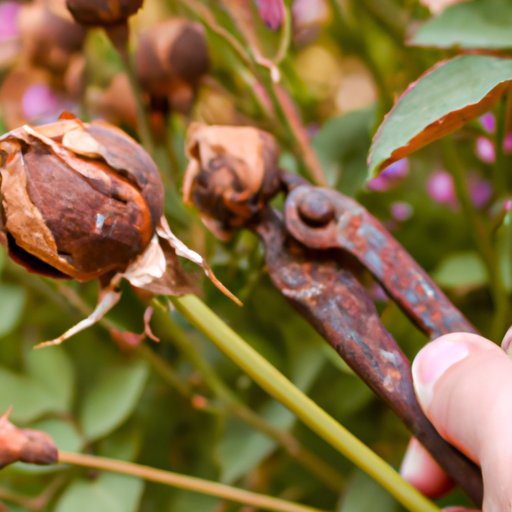
Introduction
If you’re an avid gardener, you know that roses are a cherished and common plant found in gardens all over the world. But as much as we love these beautiful flowers, they require special care to thrive and bloom. One of the most important aspects of rose care is deadheading. Deadheading is the process of removing spent blooms to promote healthy growth and encourage the production of more flowers.
In this article, we’ll discuss the basics of deadheading, essential tools, the timing, and frequency of deadheading, a step-by-step guide to the process, and tips to effectively identify and remove unwanted blooms. We’ll also discuss roadblocks that can affect rose care, such as pests and diseases, and how to manage them.
The Basics of Deadheading Roses
The primary purpose of deadheading roses is to prevent the production of rose hips, which are the small fruit-like structures that develop after the bloom dies. If left alone, rose hips can redirect the nutrients away from the plant’s blooms, preventing healthy growth and further blooming.
Additionally, removing spent blooms can encourage the plant to produce more flowers. When a flower dies, its energy is redirected to the development of seeds, rather than flowers. By deadheading, you encourage the plant to produce more buds and, as a result, more blooms.
Tools Required for Deadheading Roses
Deadheading roses does not require any special equipment. All you need is a good pair of sharp, clean pruners. The blades of the pruners should be cleaned with rubbing alcohol before use to avoid transferring diseases or pests from one plant to another.
When using pruners, it’s essential to be cautious and mindful of the location where you’re cutting. Cut just above the first set of five leaves and avoid cutting into the stem as much as possible. This will help prevent damage to the plant that could lead to health issues or prevent further blooming.
Timing and Frequency of Deadheading
The ideal time to deadhead your roses is immediately after the blooms start to die or wilt. This ensures that the plant’s energy is redirected towards producing new growth. Deadheading should be performed regularly throughout the blooming season to encourage continual growth and flowering. A good rule of thumb is to deadhead once a week during the growing season.
Factors that determine the frequency of deadheading include the specific variety of rose, the health of the plant, and the growing conditions. Roses that bloom frequently, like Grandifloras or Floribundas, may require more frequent deadheading than other varieties.
Step-by-Step Guide to Deadheading Roses
Deadheading roses is a straightforward process that you can accomplish in just a few simple steps:
- Find the stem with the spent bloom that you would like to remove.
- Locate the first set of five leaves below the spent bloom.
- Cut the stem at a 45-degree angle, immediately above the first set of leaves.
- Repeat this process for all spent blooms.
It’s important to remember not to cut too close to the leaves, as this can damage the stem and leave the plant vulnerable to disease or pests.
When deadheading roses, there are different techniques to use depending on the type of rose. For hybrid tea roses, it’s best to remove only the dead head, taking care to remove any roses that are brown or yellow. For shrub roses, it’s best to cut the dead bloom down to the first five-leaflet leaves below the bloom, and for climbers, it’s essential to remove the dead blooms, especially any that are growing inside the plant.
Identifying the Blooms to Remove
When identifying blooms to remove from your roses, consider pruning back the entire stem if there are several blooms that have wilted and died. This could help the plant produce new growth and improve overall health.
Another factor to keep in mind is how the cut blooms can be salvaged for use in a vase arrangement. To be mindful of preserving plant health, it’s best to remove blooms that are closest to their end-of-life cycle, without sacrificing the overall health and new growth of the plant. For instance, it’s not recommended to remove several blooms from one stem at the same time, as this can damage the stem and prevent further growth.
Managing Roadblocks to Successful Deadheading
Even with proper pruning and deadheading, roses can still suffer from various diseases and pests, including aphids, fungal diseases, and Japanese beetles. It’s important to be vigilant of these issues, as they can significantly affect the rose’s health and growth.
To avoid pest and disease problems, it’s essential to keep your garden clean and free of debris, regularly check often for these issues, and take appropriate steps to manage them. For example, by regularly removing and disposing of any diseased plant material, you can reduce the spread of disease and infection to other plants in your garden.
Conclusion
Deadheading roses is a simple and effective way to encourage continuous growth and ensure that your garden remains vibrant and healthy. By deadheading your roses regularly, your plants will produce more blooms, redirect energy from fruit development, and produce healthy, thriving plants. These pruning and deadheading techniques will help your roses bloom throughout the season and make your garden the envy of the neighborhood.




